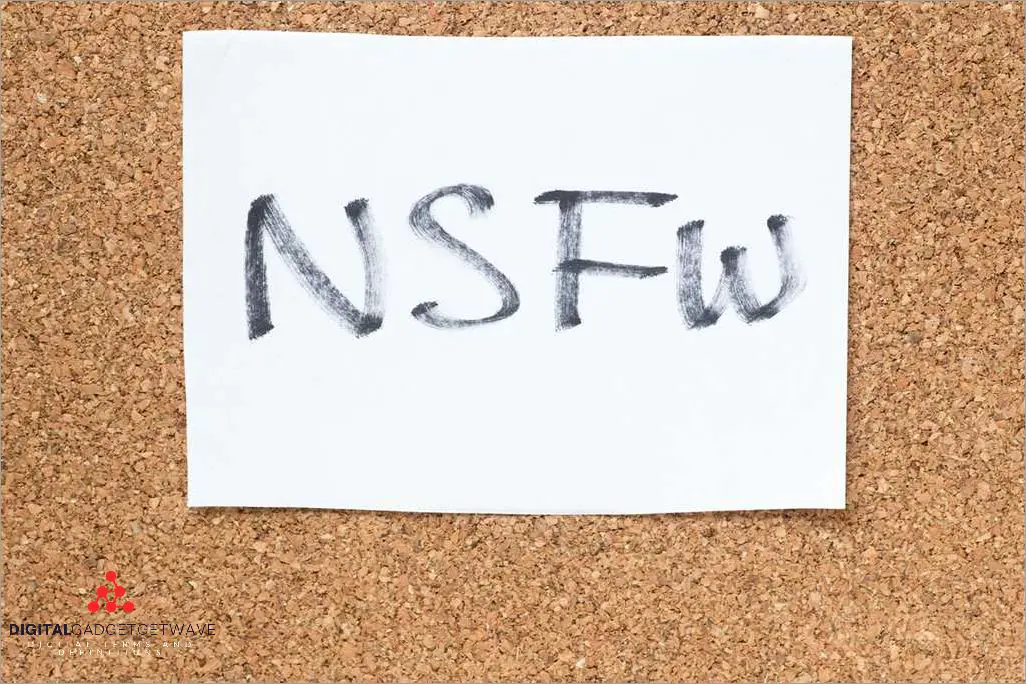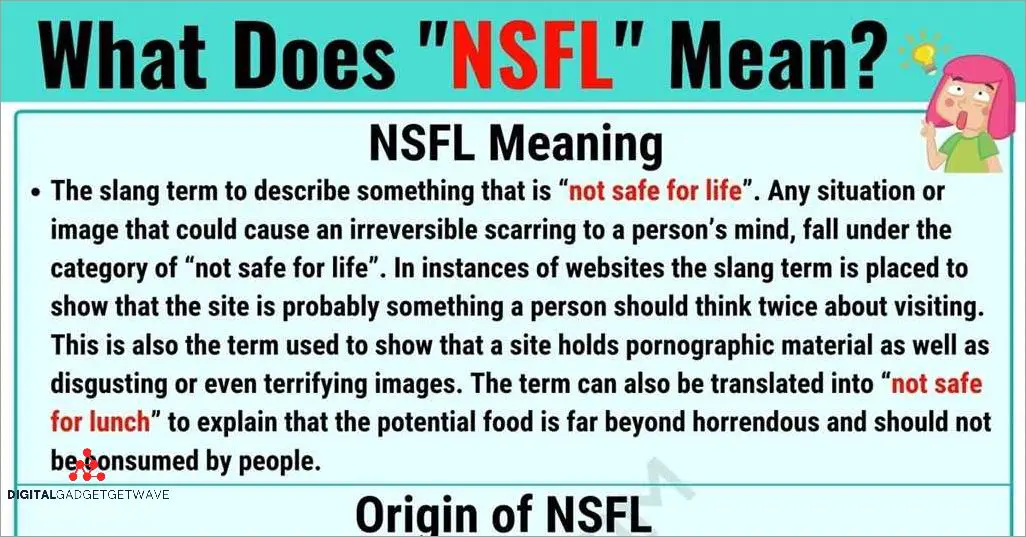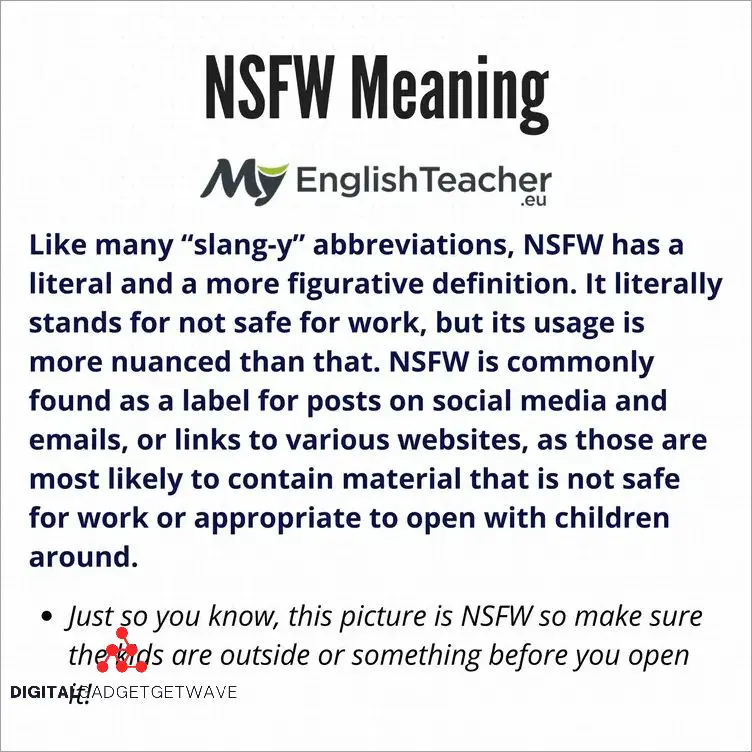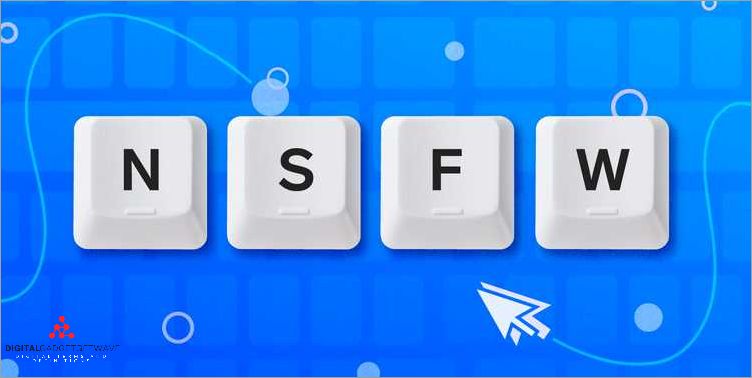
The acronym NSFW stands for “Not Safe for Work,” a term commonly used on the internet to label and warn users about content that is considered unsafe or inappropriate for viewing in a professional or public setting. NSFW content typically includes explicit, pornographic, or offensive material that is not suitable for all audiences.
Sensitive to the fact that people may be accessing the internet in a variety of environments, such as offices or public spaces, websites and online platforms often employ filters to prevent NSFW content from being displayed without warning. By labeling and restricting access to adult or mature content, these filters help to maintain a safe and professional online environment.
When encountering NSFW content, users may come across warning messages, labels, or censored graphics that serve as a visual indicator of its inappropriate nature. These measures are in place to protect individuals from inadvertently viewing or being exposed to offensive or explicit material.
It is important to note that the term NSFW is not limited to the internet, but has also become common in everyday conversations and communication. Whether used in written or spoken form, NSFW serves as a shorthand way to caution others about content that is not suitable for all audiences.
Contents
- 1 What Does NSFW Mean?
- 2 Definition of NSFW
- 3 Examples of NSFW Content
- 4 How to Handle NSFW Content
- 5 FAQ about topic “What Does NSFW Mean? Find Out the Definition and Examples”
- 6 What is the meaning of NSFW?
- 7 Why is NSFW content labeled as such?
- 8 Can NSFW content be offensive?
- 9 Is it appropriate to share NSFW content in a work environment?
- 10 What are some examples of NSFW content?
What Does NSFW Mean?
NSFW is an acronym that stands for “Not Safe for Work”. It is used to label content that is restricted and not suitable for viewing in a professional or public environment. This term is commonly used online, especially in email subject lines, social media posts, and online forums.
The term NSFW is typically used to warn users about adult or explicit content. It is often associated with content that may be censored or banned in certain contexts, such as pornographic or sexually explicit material. The purpose of using the NSFW label is to protect sensitive individuals from being exposed to inappropriate or offensive content.
NSFW content can include but is not limited to explicit images, videos, or text that is deemed to be mature or offensive. It is important to note that the definition of NSFW may vary depending on the individual’s personal views and cultural norms. Therefore, it is crucial for internet users to apply caution and use filter settings to regulate their online experience.
When encountering a warning label that says “NSFW”, it is advised to exercise caution and avoid viewing or sharing the content in question in professional or public settings. The label is meant to serve as a reminder that the content may be explicit, offensive, or potentially unsafe for some viewers.
Definition of NSFW

The acronym NSFW stands for “Not Safe for Work.” It is commonly used to label online content that is deemed inappropriate or offensive for a workplace environment. The content that comes with this label can be explicit, adult, or mature in nature, making it unsuitable for public viewing or for those under the legal age.
NSFW content may include, but is not limited to, explicit language, nudity, violence, and pornographic material. It is important to understand that the term “Not Safe for Work” does not necessarily mean that the content is illegal, but it is meant as a warning that the material may be offensive, sensitive, or taboo in nature.
The purpose of labeling NSFW content is to protect individuals from accidentally accessing or viewing content that they may find offensive or disturbing. By using a clear and recognizable warning, such as the acronym NSFW, individuals are provided with the opportunity to avoid or filter out this type of content.
It is crucial to exercise caution when interacting with NSFW content, especially in professional or public settings. Sharing or engaging with this type of content inappropriately can have negative consequences, including damage to one’s reputation or even legal consequences depending on the nature of the content.
In conclusion, NSFW is an acronym that stands for “Not Safe for Work” and is commonly used to label online content that is explicit, adult, or mature in nature. This label serves as a warning to individuals that the content may be offensive, sensitive, or unsuitable for viewing in a workplace or public environment. It is important to exercise caution and respect when encountering NSFW content, as inappropriate use or engagement can have negative consequences.
Understanding the Acronym
NSFW stands for “Not Safe For Work.” This acronym is used to label and categorize content that is considered to be restricted or unsafe for viewing in a professional or public setting.
The term is commonly used to define content that is offensive, mature, pornographic, explicit, or sensitive in nature. It serves as a warning to individuals that the content may be inappropriate for those who wish to avoid adult or explicit material.
On the internet, the NSFW label is often used in forums, social media platforms, or websites to alert users that the content they are about to view contains explicit or potentially offensive material. This allows individuals to decide if they want to proceed with caution or apply filters to censor the content.
The NSFW acronym is typically used as a quick way to convey the meaning of potentially offensive or adult content without explicitly stating the nature of the content itself. It helps users navigate the online space, indicating what type of material they may encounter and allowing them to make informed choices about their internet browsing experience.
Explaining the Meaning
The acronym NSFW stands for “Not Safe for Work.” It is a term commonly used on the internet to label content that is mature or adult-oriented. NSFW is typically accompanied by a warning or a label to indicate that it contains explicit, inappropriate, or offensive material that may not be suitable for all viewers.
NSFW content can include a wide range of material, such as explicit language, nudity, violence, or pornographic images or videos. It is important to note that NSFW content is considered unsafe or sensitive primarily in professional or public environments, where it may be seen as inappropriate or distracting.
Many online platforms, including social media sites and forums, have implemented filters or censorship measures to allow users to flag or hide NSFW content. These measures help protect individuals from stumbling upon content that they may find offensive or disturbing.
It is crucial for internet users to be aware of the meaning of NSFW to avoid accessing or sharing potentially unsafe content, especially in public or professional settings. By understanding the implications of NSFW, individuals can maintain a safer and more respectful online environment.
Examples of NSFW Content
NSFW, an acronym for “Not safe for work,” refers to online content that is deemed unsuitable or inappropriate for viewing in a professional or formal setting. The term is commonly used as a warning label to indicate that the content may contain explicit, offensive, or pornographic material. Here are a few examples of NSFW content:
- Explicit Images or Videos: This category includes sexually explicit or pornographic material that may be considered offensive or unsafe for viewing in a professional environment.
- Mature Content: NSFW content may involve discussions or depictions of sensitive topics such as drug use, violence, or graphic language.
- Offensive Language or Material: Content that includes hate speech, derogatory remarks, or discriminatory language falls under the NSFW category.
- Inappropriate Humor: Jokes or memes that are considered inappropriate or offensive can be labeled as NSFW.
- Unsafe Websites: Websites that contain malware, phishing schemes, or explicit ads are considered NSFW due to potential risks they pose to users.
- Personal Blogs or Social Media: Some individuals may use strong language, share explicit content, or post controversial opinions on their personal blogs or social media accounts, making them not suitable for a work environment.
It is important to note that the definition of NSFW may vary depending on the specific context and the individual’s personal standards. Employers often use content filters and blocks to prevent employees from accessing NSFW material to maintain a professional working environment.
Inappropriate Language
Inappropriate language refers to any form of communication or content that is considered offensive, disrespectful, or unsuitable for certain audiences. It includes any words, phrases, or expressions that may be considered vulgar, obscene, or discriminatory.
Labeling content as “inappropriate” helps to warn users that the material is not suitable for everyone. This classification is especially important in online environments, where various types of content are easily accessible by users of all ages.
One common way to filter inappropriate language online is through the use of acronyms or abbreviations. For example, NSFW (Not Safe for Work) is often used as a warning to internet users that the content may contain explicit or adult material.
The meaning of inappropriate language can vary depending on cultural and societal norms. Certain words or phrases may be restricted or censored in some contexts due to their offensive or sensitive nature.
Inappropriate language is not limited to just text-based content. It can also include images, videos, or audio that are pornographic or explicit in nature. These types of content often come with a warning label or are marked as “unsafe” to ensure that users are aware of their content.
It is important for individuals to be mindful of their language choices in both online and offline settings. Using inappropriate language can have negative consequences, such as damaging relationships or creating a hostile environment.
Explicit Images and Videos

In the online world, there is a vast array of content available to users. However, not all of this content is suitable for everyone. Explicit images and videos are examples of this type of content. These explicitly labeled materials are considered offensive and may not be safe for all viewers, especially younger or more sensitive individuals.
Explicit images and videos often contain mature or pornographic content, which is intended for adult audiences. They go beyond the boundaries of what is considered appropriate for general consumption. To protect users from stumbling upon such content accidentally, explicit images and videos are typically labeled with warnings or are restricted to specific age groups.
The definition of explicit content varies depending on the platform or website. Some websites have their own guidelines for determining what is considered explicit and may label or censor certain material accordingly. Overall, explicit material is characterized by its graphic and sexually explicit nature, which is deemed inappropriate for general viewing.
It is important for internet users to be aware of the meaning of the acronym NSFW (Not Safe For Work) and to take caution when browsing online. This acronym serves as a warning that the content being shared or accessed is not suitable for a professional or public setting. By implementing measures such as content filters and parental controls, users can minimize the risk of coming across explicit images and videos.
Sensitive or Controversial Topics
When discussing sensitive or controversial topics online, it is important to carefully consider the nature of the content being shared. These topics may include mature or adult discussions, offensive language or imagery, or controversial viewpoints. It is crucial to label such content appropriately in order to provide a warning to users who might find it inappropriate or offensive.
One common way to label sensitive or controversial topics is by using the acronym “NSFW,” which stands for “Not Safe for Work.” This acronym is often used to indicate that the content contains explicit or pornographic material. By including the NSFW label, internet users are alerted to the presence of potentially unsafe or adult-oriented content, allowing them to make an informed decision about whether to view it or not.
Another method of managing sensitive or controversial topics online is through content filters. These filters can be implemented on websites and social media platforms to restrict access to certain content or to provide a warning before users can view it. This helps to ensure that individuals who do not wish to be exposed to mature or offensive content can avoid it, while still allowing others who are interested to access it.
The definition of what is considered sensitive or controversial can vary depending on cultural, personal, and social factors. For example, what may be deemed as offensive or inappropriate in one country or community, may be seen as acceptable in another. It is important to consider these differences when discussing such topics in an online setting.
In conclusion, sensitive or controversial topics on the internet should be approached with caution. Proper labeling, the use of acronyms like NSFW, content filters, and respect for cultural differences are important elements in managing these discussions. By implementing appropriate safeguards, we can create a more inclusive and respectful online environment for everyone.
How to Handle NSFW Content
When dealing with NSFW (Not Safe for Work) content, it is important to have proper filters in place to prevent explicit material from being displayed. NSFW content refers to anything that is not suitable for a professional or public setting, including offensive, pornographic, or inappropriate material.
To handle NSFW content responsibly, it is crucial to clearly label any adult or sensitive content as such. This can be done by using tags or warnings that indicate the nature of the material, allowing individuals to make informed decisions about whether or not they want to view it.
The internet is filled with NSFW material, and it is essential to understand the meaning and consequences of accessing such content. This is especially important in professional settings or when using devices that are shared with others.
Many websites have implemented systems that automatically filter out NSFW content or restrict access to it. These filters can be set to block explicit or mature material, creating a safer online environment for users.
In cases where NSFW content needs to be shared, such as in an educational or artistic context, it is important to provide clear warnings and ensure that the material is censored or restricted appropriately. This helps maintain a respectful environment and prevents others from being exposed to content they may find offensive or uncomfortable.
In conclusion, handling NSFW content requires responsible actions to ensure that it is properly labeled, filtered, and restricted. By implementing these measures, we can create a safer and more respectful online space for all users.
Implementing Filters

Implementing filters is crucial for maintaining a safe and appropriate online environment. With the proliferation of the internet and the accessibility of various types of content, it is important to have mechanisms in place to prevent the display of pornographic, offensive, or inappropriate material.
Filters are programs or tools that can be implemented to scan and categorize online content based on specific criteria. One common use of filters is to detect and label mature or adult content. For instance, a filter can be set up to identify and label websites or images that contain explicit imagery or language.
The NSFW acronym, which stands for “Not Safe for Work,” is often used as a warning label for content that is considered too sensitive or adult-oriented for the workplace or public spaces. Filters can be programmed to recognize the NSFW label and restrict access to such content.
Implementing filters can also help in preventing the exposure of unsafe or harmful content to vulnerable audiences, such as children. By applying filters, parents or guardians can restrict access to websites or social media platforms that contain explicit or offensive material.
In addition to content filtering, filters can also be used to censor or block specific keywords or phrases. This can help in reducing the visibility of offensive or inappropriate content in online discussions or comments sections.
Overall, implementing filters is an essential measure to ensure that internet users are protected from encountering content that is not suitable or safe for their intended purpose. By having effective filters in place, individuals and organizations can create a safer online environment and reduce the risks associated with accessing inappropriate or offensive content.
Creating Clear Policies
Creating clear policies regarding sensitive and restricted internet content is essential for maintaining a safe and respectful online environment. One commonly used acronym in this context is NSFW, which stands for “not safe for work”. NSFW content refers to materials such as explicit, pornographic, or offensive content that is not suitable for viewing in professional or public settings.
To ensure that employees or internet users are aware of the potential risks associated with NSFW content, it is important to label or tag such material appropriately. This can be done by applying clear warning labels, such as “Mature Content” or “Not Suitable for Work”, to indicate that the content may be inappropriate or offensive.
In addition to labeling NSFW content, implementing a robust internet filter can help to prevent employees or internet users from accessing unsafe or explicit content. This filter can restrict access to websites or online platforms that are known for hosting NSFW material, providing an additional layer of protection.
It is crucial to provide a clear definition of what constitutes NSFW content, as the meaning may vary depending on the context. This definition can include examples of content that would be considered inappropriate for a professional or public setting, such as explicit images, violent or graphic material, or hate speech.
By establishing clear policies and guidelines regarding NSFW content, organizations can create a safe and respectful online environment for their employees or internet users. This can help to prevent the exposure to offensive or harmful material, and promote a positive and inclusive online culture.
Providing Employee Training

When it comes to sensitive content on the internet, it is important for companies to provide proper employee training. This training should educate employees about the potential risks and consequences of accessing or sharing censored or restricted content.
One aspect of such training is teaching employees how to identify and avoid adult or not suitable content. This includes understanding the meaning of NSFW, an acronym that stands for “Not Safe for Work.” Employees should be aware that this warning label usually indicates pornographic or offensive content.
Furthermore, it is crucial for employees to understand what is considered inappropriate or offensive content. Through training, employees can learn to recognize explicit or mature material and know how to report or handle such situations appropriately.
In addition to education, companies can implement safety measures like internet filters to prevent access to unsafe or explicit content. Employees should be made aware of these filters and understand their purpose in maintaining a safe and productive work environment.
Overall, providing comprehensive employee training on sensitive and inappropriate content is essential in promoting a culture of respect and professionalism within the workplace. By educating employees on the risks, consequences, and strategies for avoiding such content, companies can help create a safer online environment for everyone.
FAQ about topic “What Does NSFW Mean? Find Out the Definition and Examples”
What is the meaning of NSFW?
NSFW stands for “Not Safe for Work”. It is an internet acronym that is used to label content that is not appropriate to view in a professional or public setting, such as explicit images, videos, or discussions.
Why is NSFW content labeled as such?
NSFW content is labeled as such to warn viewers that the content may contain explicit or inappropriate material. This allows individuals to make an informed decision about whether or not they want to view the content, especially in a professional or public setting where it may be inappropriate or offensive.
Can NSFW content be offensive?
Yes, NSFW content can be offensive. It may include explicit sexual or violent material, or content that promotes hate speech, discrimination, or other harmful behaviors. It is important to be respectful and mindful of others when sharing or consuming NSFW content.
No, it is generally not appropriate to share NSFW content in a work environment. NSFW content can be offensive or highly explicit, and sharing it in a professional setting can create a hostile or uncomfortable work environment. It is best to avoid sharing or accessing NSFW content while at work to maintain professionalism and respect for others.
What are some examples of NSFW content?
Some examples of NSFW content include pornography, explicit images or videos, graphic violence, hate speech, and discriminatory or offensive material. It is important to note that the definition of NSFW may vary depending on individuals and cultural norms.


